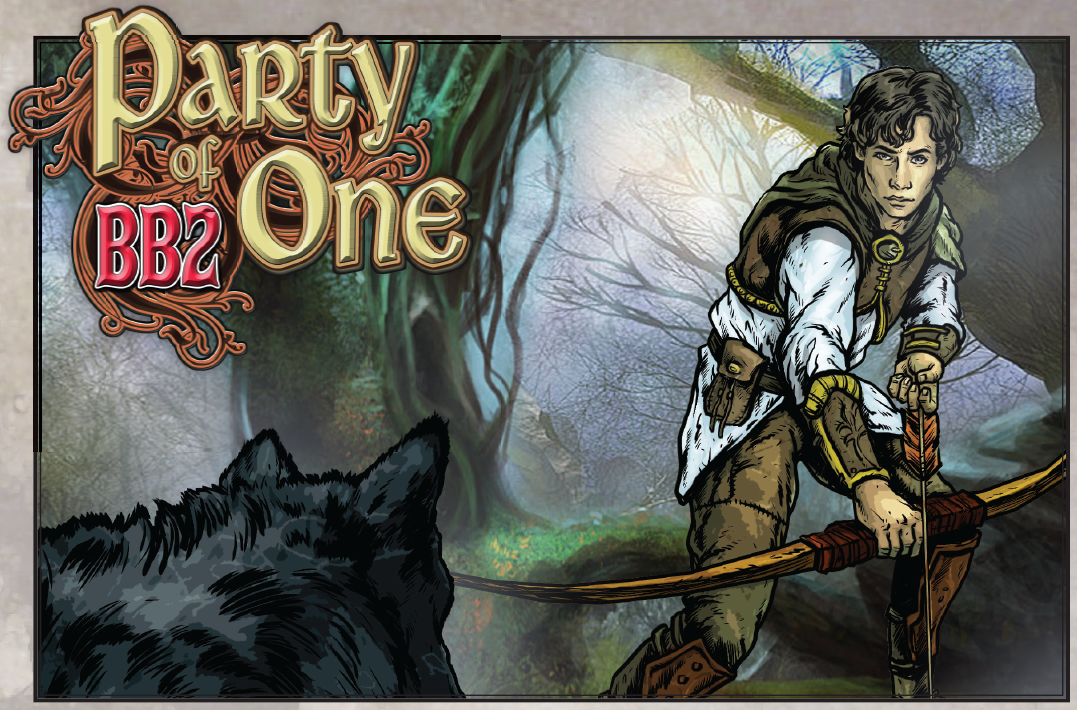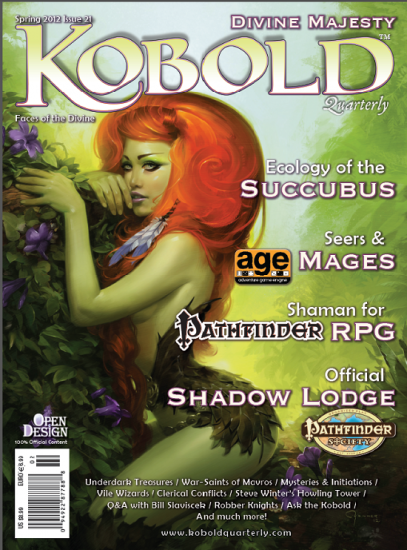Spring has sprung, and with the turning of the seasons comes… a new edition of Kobold Quarterly! KQ Spring #21 is their “Divine Magic” issue, and as usual, I’m going to give you a quick rundown of what is inside the issue, whether it is Pathfinder/Third Edition, Dungeons and Dragons Fourth Edition, Dragon Age, or general purpose, and whether it’s good, bad, or ugly. As an added bonus, I’m going to be talking about Open Design “Party of One” adventures by Matthew Hanson. These are Choose Your Own Adventure-style adventures in the vein of the Lone Wolf paperbacks that haunted my childhood bus rides. Adventures for a single player; all you need are a couple of dice, a pencil and the adventure, and you are all set. Great fun; I was having flashbacks to balancing a book on my knees while rolling dice on the seat of the schoolbus while I was… balancing the pages on my knees, hitting a random number generator on the subway ride to work. You’ve come a long way, kid!
The issue opens up talking about portrayals of women in fantasy, something related to Emmet Asher-Perrin’s article on the subject. “The Shaman” is a Pathfinder base class, and is essentially a spontaneous casting druid. A little too druid-y if you ask me, since they have an animal companion and wild shape too, but the addition of “Totem Secrets” adds a nice bit of flair, sort of like the Third Edition wu jen’s “Spell Secrets.” Something I did really like about this article was the use of fluid naming conventions for the sample “spirit guides.” Buffalo or bison, condor or vulture, cougar or jaguar, that kind of thing. Just by word choice you can tweak the flavor of the thing; ain’t language grand? “The Ecology of the Succubus” was less interesting to me; not that it is bad, but there isn’t anything here that you wouldn’t expect, except perhaps “womb-mothers,” the special succubi that can bear young. There is a neat 4e “Channel Divinity” feat that lets you “reveal” that a newly met NPC is part of your infernal conspiracy, though.
Zeb Cook’s “It’s a Mystery!” is a primer on mystery cults and how to add them to your game, and it’s a nice chunk of inspirational history no matter what rule system you use. It falters at the end by not giving you any ideas for the core mysteries of initiation. I wanted to see some ideas, perhaps even some mechanics—maybe there is a mystery cult at the heart of the mechanics of a druid’s shapeshifting or cleric’s turn undead, maybe there are some 4e themes or Pathfinder feats that could he been added? “Clerical Conflicts” follows, and it is just a crackerjack piece of writing. Were-angels, messiahs, priests abandoned by their gods, all held up by elegant rules for Pathfinder… and the examples used all weave together into a subtle meta-narrative. “Why No Monotheism?” addresses the multiple gods assumption in fantasy roleplaying, but frankly I’m more interested in the author’s note contrasting the “patron god” henotheism of the game and the absence of the more “we worship the whole pantheon” approach. Kathenotheism is what you called that; hey, I learned a new word! Ain’t language grand?
“Divine Archetypes” goes into tricky ground, but does it with panache. I’m on the record as saying The Book of Exalted Deeds was my least favorite Third Edition Dungeons and Dragons book, but this Pathfinder article avoids those pitfalls. Plus, a “holy gunslinger” archetype called a “peacemaker” is just spot on, as are the mechanics for being a fighter with an angelic buddy and a Shinto-esque ranger option called the “spirit hunter.” We’ve got a big interview with Bill Slavicsek next, which—honestly, interviews aren’t really my thing, so I skimmed it, though I was happy to see Planescape get its due props. “A Background in Magic” is the only AGE specific article in here, and if there is one thing I know about AGE, it is that people are clamoring for content—Backgrounds and Specializations, in particular. “From the Mines” and “Ask the Kobold” are the staff answering letters, both about the magazine and about game mechanics. “The Scriveners of Allain” is a Fourth Edition article about…evil scribes with ink magic? Reminiscent of China Miéville’s Kraken, but not particularly sinister.
The last few articles in this issue are pure gold. The last issues of KQ had derro ooze magic, dire naked mole rats and the kami “Lurker in the Cave,” and this issue doesn’t stint on The Weird, either. “Nine Treasures of Midgard” doesn’t feature handcuff cheese, like the art seems to portray, but it does have more derro madness with a box of saws and gear teeth, drow brandy and canned heads. “Saints of Mavros” is a Pathfinder article—I’ve always found their pantheon bland, but these saints spice up the church of the god of war, especially Saint Whiteskull, beatified warlord of the Ghoul Imperium. Oh, and you know those horrifying ocean bugs that eat a fish’s tongue and then live in their mouths? Well “White Tongue, Black Heart” gives your terrible wizard Pathfinder rules for having one as your familiar. So… that is pretty much the worst, in the best possible way.
“Silus and the Red Dogs” was an article Kobold Quarterly #18, but the subsequent “Party of One” adventures that have been extended and are now available separately, are totally worth it. Being made for adults allows these “Party of One” adventures to be more complex than your standard Choose Your Own Adventure fare. Branching pathways in the flowchart that the player has to return to, but that allow new options based on what you discover from the choices you’ve pursued, items that alter the flow of the story or the abilities of your character in a fight, secrets that open up different dialogue trees; it is pretty neat, actually.
I decided to try out Kalgor Bloodhammer and the Ghouls Through the Breach first. I concluded the adventure without dying, but I think I played the “good little soldier” a bit too well; as a player and a character I have suspicions about the things I missed, but I’ll have to go back and replay it a little more slyly to see those outcomes. Hey! Look at that! I already want to replay the thing; I’d say that makes for a pretty good value. Twist and turns, secrets and fights—the random element really adds a degree of just organic drift that wouldn’t happen otherwise. I made decisions based on my hit point total twice in the adventure that I might have done differently had I been in better or worse shape.

Actually, when I played Elgar Fletch and the Dark Army the same thing happened; I stayed on task, didn’t get distracted, and ended up finishing the story with a generic happy ending, knowing terrible secrets went uncovered. I did get a sweet elven cloak out of the deal; the story opens with a choice between buying an elven cloak, a dwarven charm or saving your gold, which is a really great cold open. I will say I’m a bit distressed at the overwhelming “boy’s club” feel so far; I’d like a female protagonist!
I tried to play Alosar Emanli and the Creatures From the Fallen Star a little more curiously, but luck wasn’t with me. A friend of mine had played this adventure and had been excited to get a bear cub as a sidekick, but I failed at the bear cave, and failed again later on when evil spaceworms attacked the bears, so I was solo on this one. I used up all my spells—spells! Another of those fun complications—and couldn’t confront the aliens myself, so I ended up having to crawl away for help… and almost killed myself climbing a tree for a nixie. The dice hated me… which just proves that these stories really are different depending on your choices and your luck, since my non-gamer friend found this one to be “too easy.”
Next issue: Dwarves, dwarves, dwarves! and rogue archetypes from the author of “White Tongue, Black Heart”!
Mordicai Knode is pretty sure some necromancer is summoning those ghouls to prop up a decaying dwarven military-industrial complex; if you find out the secret, will you tell it to him on Twitter?










